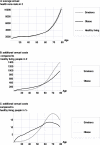Lifetime medical costs of obesity: prevention no cure for increasing health expenditure
- PMID: 18254654
- PMCID: PMC2225430
- DOI: 10.1371/journal.pmed.0050029
Lifetime medical costs of obesity: prevention no cure for increasing health expenditure
Abstract
Background: Obesity is a major cause of morbidity and mortality and is associated with high medical expenditures. It has been suggested that obesity prevention could result in cost savings. The objective of this study was to estimate the annual and lifetime medical costs attributable to obesity, to compare those to similar costs attributable to smoking, and to discuss the implications for prevention.
Methods and findings: With a simulation model, lifetime health-care costs were estimated for a cohort of obese people aged 20 y at baseline. To assess the impact of obesity, comparisons were made with similar cohorts of smokers and "healthy-living" persons (defined as nonsmokers with a body mass index between 18.5 and 25). Except for relative risk values, all input parameters of the simulation model were based on data from The Netherlands. In sensitivity analyses the effects of epidemiologic parameters and cost definitions were assessed. Until age 56 y, annual health expenditure was highest for obese people. At older ages, smokers incurred higher costs. Because of differences in life expectancy, however, lifetime health expenditure was highest among healthy-living people and lowest for smokers. Obese individuals held an intermediate position. Alternative values of epidemiologic parameters and cost definitions did not alter these conclusions.
Conclusions: Although effective obesity prevention leads to a decrease in costs of obesity-related diseases, this decrease is offset by cost increases due to diseases unrelated to obesity in life-years gained. Obesity prevention may be an important and cost-effective way of improving public health, but it is not a cure for increasing health expenditures.
Conflict of interest statement
Figures


Comment in
-
Does preventing obesity lead to reduced health-care costs?PLoS Med. 2008 Feb;5(2):e37. doi: 10.1371/journal.pmed.0050037. PLoS Med. 2008. PMID: 18254656 Free PMC article. Review.
References
-
- Haslam DW, James WP. Obesity. Lancet. 2005;366:1197–1209. - PubMed
-
- Rodgers A, Ezzati M, Vander Hoorn S, Lopez AD, Lin RB, Murray CJ. Distribution of major health risks: findings from the Global Burden of Disease study. PLoS Med. 2004;1:e27. doi: 10.1371/journal.pmed.0010027. - DOI - PMC - PubMed
-
- Roth J, Qiang X, Marban SL, Redelt H, Lowell BC. The obesity pandemic: where have we been and where are we going? Obes Res. 2004;12(Suppl 2):88S–101S. - PubMed
-
- Organization for Economic Cooperation and Development. Health at a glance. Paris: OECD; 2005.
Publication types
MeSH terms
LinkOut - more resources
Full Text Sources
Medical

